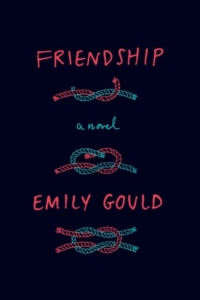 [FSG; 2014]
[FSG; 2014]
Friendship contributes to a mishmash contemporary genre about young white educated people in New York. The novel is aware of this, and plays to its type (at one moment, there appears to be an elaborate reference to Whit Stillman’s Last Days of Disco being made, by way of an awkward flirtation the subject of which is Scrooge McDuck). Typical of this genre, Friendship advocates a tentative conservatism, charting a trajectory from young white educated life, full of pain, possibility, and disorganization, into older white educated life, where interpersonal boundaries, professional achievement, and financial security keep people safe and relatively happy. At the same time, the travails of the main characters (including financial ruin and single pregnancy) seem to productively nag at some of the assumptions of what functional adult life is supposed to look like for this demographic, and the story occasionally seems to criticize the negative cultural trends it depicts.
The book opens with one of the two protagonists, the demure Bev, running into a former co-worker on the subway in New York. He worked at her old job (literary agency) and she’s going to her new job (temp agency) and she’s embarrassed to be déclassé. A little later in the book, Bev gets pregnant (by a skeevy acquaintance, who she meets while temping). The pregnancy itself is some amalgam of a plot device and a mirror for Bev’s feelings about herself; she is shown to have grown up by being brave enough to keep the baby despite her embarrassment at being white, pregnant, and unmarried.
Bev’s embarrassment is not soothed by her close friend Amy, a slightly tougher, more obsessive older sister character, who thinks Bev should get an abortion, and has trouble keeping her opinion to herself. Amy is a charming mess, who is trustworthy in that she is totally “incapable of lying,” which ultimately enables her to admit that she is jealous of Bev for getting to be a mother.
The book toys with deep reflection about what it means for young unmarried people to commit to each other as friends. Amy and Bev have a “defining the relationship” talk, in which they agree that they are “best friends.” At various points in the book, they choose allegiance to one another over no-count men in their lives. But as with their various romances with unavailable dudes, Bev and Amy’s incompatibilities with each other emerge and put stress on their nebulous bond.
In one of my favorite essays, Dean Spade argues that part of integrating radical politics into our relationships involves destabilizing the myths around getting all one’s needs met from one romantic partner, and treating one’s friends more like romantic partners (carving out special time for them, working on the relationship, etc.). In Friendship, Bev and Amy dance around this theme, but as their relationship deteriorates, and Bev commits to her [pregnant] self, the question of how straight, professionalized, upwardly aspirational (if not actually upwardly mobile) white people (and specifically women) should use their close friendships to make their lives — and the world — better, does not completely get answered.
Friendship also has some hang-ups about class. Americans live in a culture where money is necessary to live. We also live in a culture where how much money you have determines what you can do, who you’re supposed to hang out with, and even how you’re supposed to feel about yourself. So saying that a contemporary American novel is “about money” might seem unspecific, if everything is kind of about money. But disclaimer aside, some of the weirdest parts of Friendship are when money gets loosely equated with other good qualities (and vice versa).
Throughout the book, different older characters appear, all of whom are affluent, and all of whom seem to be doing OK. Bev’s older friend Sally (whose husband Amy sleeps with, kind of by accident) goes through a divorce in the novel (see previous parenthetical), but for some reason, Sally has almost no tough emotions or existential woe about this. The difference between Sally and the two protagonists, of course, is that Sally does not worry about money.
The fascination with (and uncritical appreciation of) wealth in the book is complemented by the occasional derision of poor or non-professional peoples of various kinds. In an extreme example, one bar is described: “the beers were so cheap and the patrons so poor and unattractive that it seemed like an elaborate re-creation of a bar in a different city.”
On the one hand, the novel realistically recreates the intense, veiled classism that seems typical of young white college grads floundering in New York (at least in my own experience). On the other hand, the critical lens being applied to this demographic phobia of poor people is spotty. For the most part, the characters in the book assume that all people who live in NYC are rich and white, and all else is a bizarre aberration. Amy goes to a soup kitchen — and has a redemptive experience helping poor people — only once she leaves New York. Again, it’s unclear if this is a stylized exposition of class segregation in one of the most unequal places in America, or if the book itself is complicit in a fearful, invisibilized, dehumanized depiction of the poor.
In a similar vein, at times the book walks a fine line between depicting the dysfunction of sexist capitalism (why is Amy having frenzied daydreams about tearing off other women’s wedding rings while her unemotional boyfriend is passively breaking up with her by moving to Spain to work on his art?) and mythologizing it. The braided pressures to have a conventional life (i.e., get married) and to have status (i.e., be rich and look fancy) largely define the struggles of Bev and Amy.
Bev becomes comfortable with the idea of herself as a single mother, but only as she increasingly befriends (and gets financial and professional assistance) from older, conventionally successful rich ladies. Amy’s trajectory is only slightly more heartening from a political standpoint (she ends up managing an ice cream store outside DC, and kind of feeling good about it) and the novel hints that she will get her affirmation as a “serious” professional eventually.
There is a micro-theme in the novel about religion, Bev’s modesty and self-doubt having roots in an idea of a puritanical punishing god figure, and Amy’s confusion about how to be a good friend getting no help from her soupy, yoga-inspired ideas of self-acceptance. But like most dominant cultural institutions for white middle-class people (e.g., the New York Times, most private colleges), the novel seems to believe that through some mysterious blend of experience, humility, and financial security, we can all be good people.
For white middle-class readers who are coming of age in our time, the plotline of Friendship will contain few surprises. Grad school, debt, embarrassing jobs, shitty apartments, and awkward hook-ups are what happens in this book. The internal experience of the main characters is also familiar ground: a nonsensical obsession with fame and notoriety, a kind of existential flakiness, an absence of any firm ethics or moral reasoning.
The book also has moments of deep tenderness, spaces where the fundamental pain of being a non-affluent woman in a sexist capitalist culture is mitigated by the power of friendship and community. The confusion and woe the characters experience as they thrash around their tiny apartments and dysfunctional workplaces is funny and occasionally heartrending. In spite of how backwards some of the actions and beliefs of Amy and Bev seemed to me — or perhaps because of the backwardness — I found myself rooting for them.
And in this way Friendship — with its ambiguity about class and identity notwithstanding — is a hopeful book. While I hope that in the sequel (Friendship Too?) the characters become organizers, raise kids communally, and devote their lives to some kind of fight for social justice, this story itself, told by a woman, about women, is in some ways refreshing. The plainest thematic wisdom from the book, that our lives develop in relation to others, and that preservation of those relationships is sometimes at odds with our own development, is helpful.
And having come up in a culture with a lot of unanswered questions, a dearth of cultural institutions that convincingly tell us (generationally) how to be, and for some of us, a real lack of spiritual possibility, the wish that we can sort it out and feel good about ourselves and our communities is both modest and also, in a subtle way, numinous.
This post may contain affiliate links.







